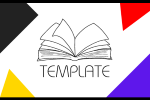Online Submissions
Registration and login are required to submit items online and to check the status of current submissions.
Author Guidelines
For writers who want to contribute to this journal can see information about the management and publishing of dekave in the Peer Review Process. Every writer who wants to contribute to dekave must register in this electronic journal system through the login menu located at the top of this site. Online registration is free of charge.
- Uploading can be done in the following ways:
- Log in using the username and password that was registered or sent to the author's email.
- Next select Submissions and
- Don't forget to upload the script in step 2 in the New Submissions section.
- Perform the steps for the article submission process to step 5
- Click Finish Submission.
- The manuscript length between 3000 to 5000 words, A4 size paper (210 x 297 mm) in the manuscript format according to the template provided, including figures and tables. The manuscript is written with an upper limit of 3 cm, 3 cm right, and 4 cm for the lower and left borders.
- Title, keywords, and abstract are written in Indonesian and English.
- The maximum number of title words is 12 words. If the title is too long, the editor has the right to edit the title without changing the meaning of the title and without the author's approval.
- The article begins with Abstract. Written in Indonesian and English; Calibri fonts; size 11; concise, factual, and able to stand alone as a unit of information. Explain the study's main points, including background, purpose, focus research, methods used, findings, results, and conclusions. End with a final sentence covering what you most want the reader to be interested in reading this article. Write with one space, and the article length is between 100 - 250 words.
- Keywords contain four to eight words, separated by commas. Keywords are chosen carefully to reflect the article's concepts and help increase the article's accessibility.
- Article writing systematic must contain:
- Introduction - The introduction contains the background to your research and the reasons why your research is important. Write down critical questions to address in your research and why readers should be interested.
- Methods - The Methods section describes how you did your research to:
(1) enable readers to evaluate the work is done and (2)
allow others to replicate your study. It would be best to describe
exactly what was done, how the experiment was carried out, how
often, where, when, and the equipment and materials used. - Results and Discussion - The purpose of the results and discussion is to state your findings, make interpretations and/or opinions, explain your findings' implications, and make future research suggestions. Results and Discussion's main function is to answer questions raised in the introduction and explain the discussion by existing knowledge about the topic. Results and Discussion are considered the heart of the article and usually require some writing effort.
- Conclusion - A conclusion is not just a summary of the main topics covered or a restatement of your research problem, but a synthesis of the main points.
- References - References using APA style with a minimum of 10 reference sources, with> 70% being publications in the last 10 years. We strongly recommend that authors use reference managers such as Mendeley, Zotero and others.
- The editorial team will perform a similarity check using the Turnitin application. For the similarity index that exceeds 30%, the editorial team will not process the script to the next stage.
- Please check the status of your article regularly by first logging in with your account.
- Authors whose articles have been accepted and ready to be published are charged a fee of 250,000 / article.
Submission Preparation Checklist
As part of the submission process, authors are required to check off their submission's compliance with all of the following items, and submissions may be returned to authors that do not adhere to these guidelines.
- The submission has not been previously published, nor is it before another journal for consideration (or an explanation has been provided in Comments to the Editor).
- The submission file is in OpenOffice, Microsoft Word, RTF, or WordPerfect document file format.
- Where available, URLs for the references have been provided.
- The text is single-spaced; uses a 12-point font; employs italics, rather than underlining (except with URL addresses); and all illustrations, figures, and tables are placed within the text at the appropriate points, rather than at the end.
- The text adheres to the stylistic and bibliographic requirements outlined in the Author Guidelines, which is found in About the Journal.
- If submitting to a peer-reviewed section of the journal, the instructions in Ensuring a Blind Review have been followed.
Privacy Statement
The names and email addresses entered in this journal site will be used exclusively for the stated purposes of this journal and will not be made available for any other purpose or to any other party.






